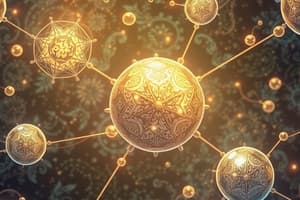Podcast
Questions and Answers
Which statement about electric charge is true?
Which statement about electric charge is true?
- Electric charge has no effect on objects.
- Like charges repel each other. (correct)
- Like charges attract each other.
- Unlike charges repel each other.
How is electric current conventionally defined?
How is electric current conventionally defined?
- As the flow of protons through a conductor.
- As the movement of electrons from negative to positive.
- As the flow of electrons from positive to negative.
- As the movement of charge from positive to negative. (correct)
What is the primary characteristic of a conductor?
What is the primary characteristic of a conductor?
- It cannot conduct electric current.
- Electrons are bound tightly to their own atom.
- It has a positive charge.
- Electrons move freely from atom to atom. (correct)
What is the charge of a neutron?
What is the charge of a neutron?
Which of the following materials is considered an insulator?
Which of the following materials is considered an insulator?
Study Notes
Structures of Matter
- Elements consist of a single type of atom, forming the basic building blocks of matter.
Definitions
- Proton: Positively charged particle located in the nucleus of an atom.
- Neutron: Neutral particle found in the nucleus, contributing to atomic mass.
- Electron: Negatively charged particle that orbits the nucleus at high speeds in energy shells.
Laws of Electric Charge
- Like charges repel each other while opposite charges attract.
Graphical Symbols for Electrical Components
- Cell: Represented by + - symbols indicating positive and negative terminals.
- Battery: Shown with - + - symbols for multiple cells.
- Resistor: Symbol not specified; used to limit current flow.
- Incandescent Lamp: Symbol not specified; produces light by heating a filament.
- Fuse: Symbol not specified; provides overcurrent protection.
- One Way Switch: Symbol not specified; allows current flow in one direction.
- Ammeter: Illustrated as + A - to measure electric current.
- Voltmeter: Depicted with + V - to measure voltage.
- Ohmmeter: Denoted with - Ω - to measure resistance.
Electric Current Flow
- Electric current results from the movement of free electrons through a conductor.
- The flow conventionally moves from positive to negative, while actual electron flow is from negative to positive.
- Current is measured in Amperes (A).
Conductors
- Materials that allow easy electron movement include copper, aluminium, and steel.
Insulators
- Materials that hold electrons tightly to their atoms, preventing flow, include PVC, rubber, and plastic.
Studying That Suits You
Use AI to generate personalized quizzes and flashcards to suit your learning preferences.
Description
Explore the fundamental concepts of matter structures, including the definitions of protons, neutrons, and electrons. Understand the laws of electric charge and the graphical symbols used for various electrical components through this engaging quiz.




